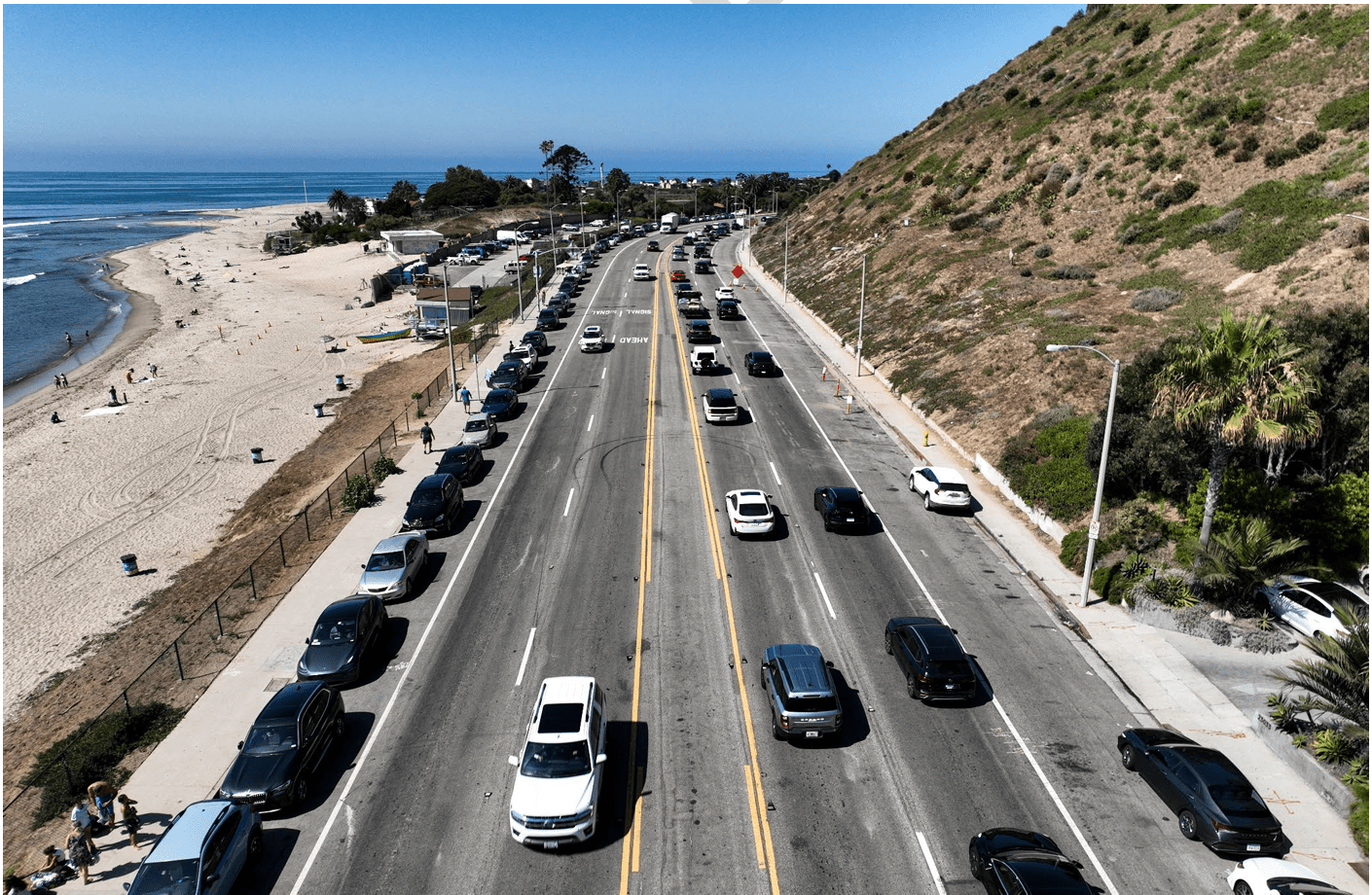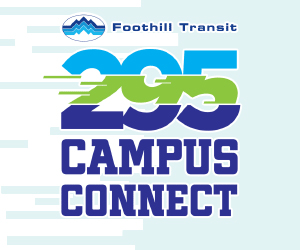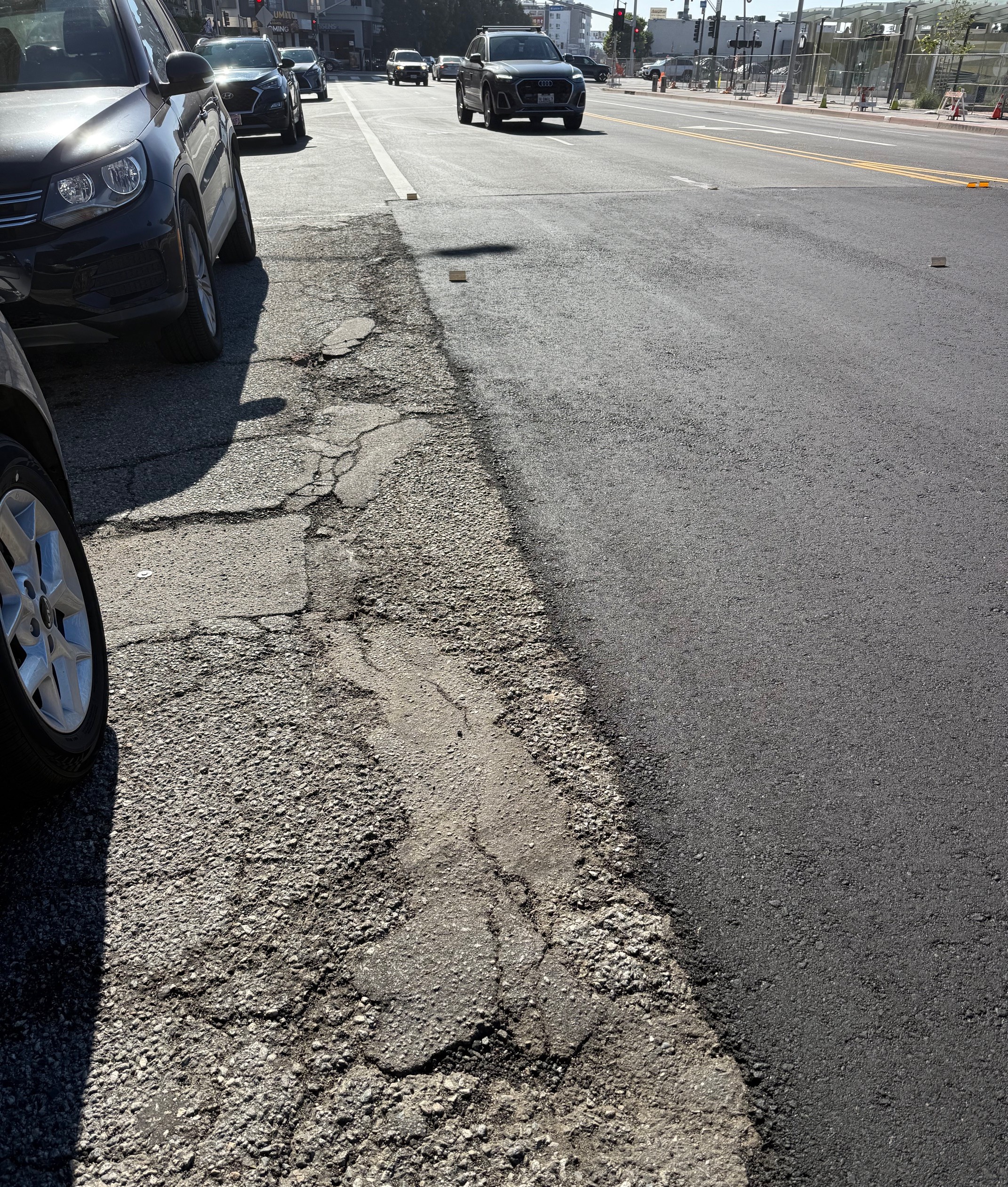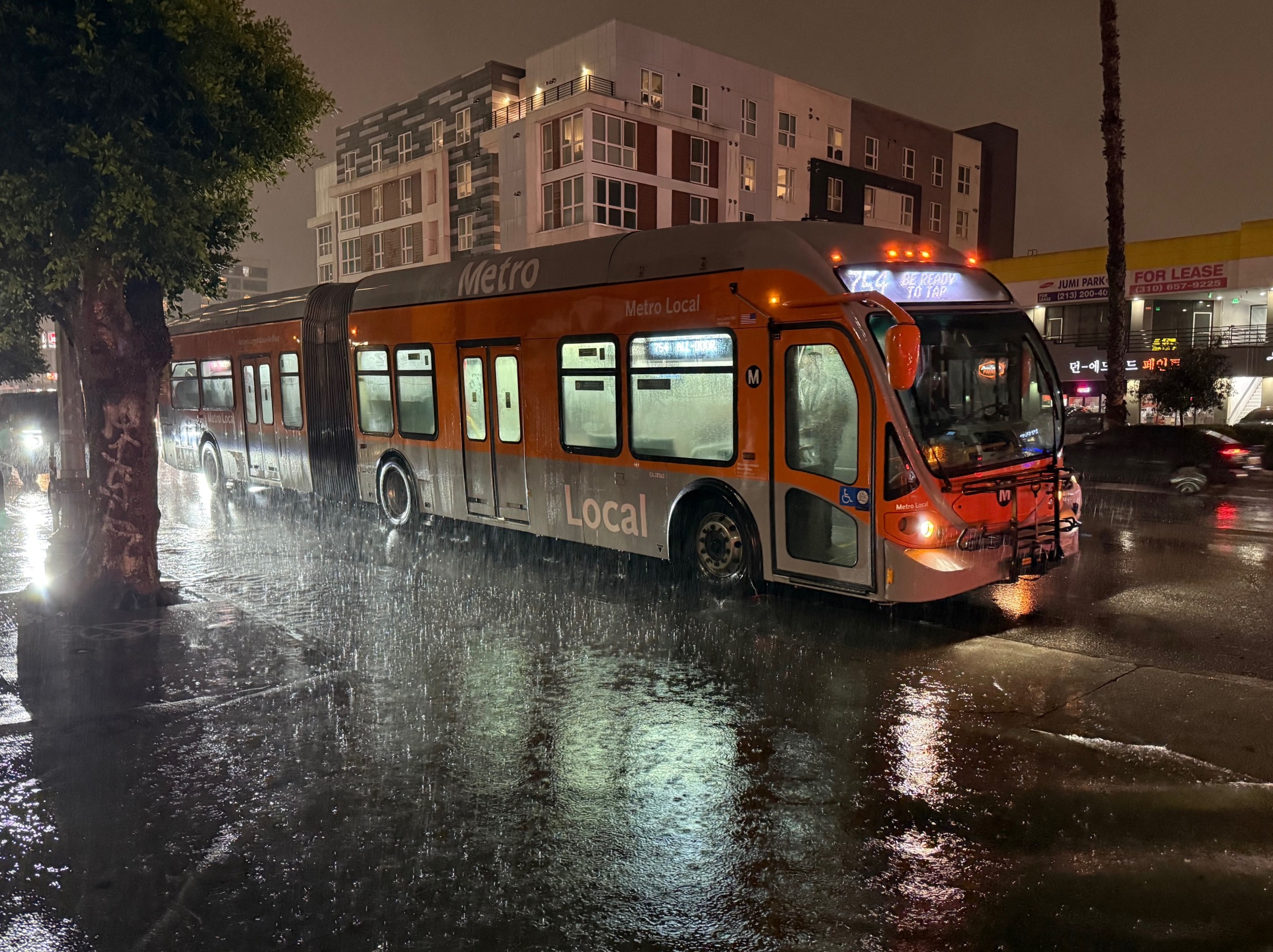Caltrans has released the Draft Pacific Coast Highway Master Plan Feasibility Study Document (PDF) for bicycle, pedestrian, and transit improvements along just over 20 miles of the Pacific Coast Highway (PCH) in Malibu. The master plan covers twenty years of projects that could be completed, should funding become available.
A virtual meeting will be held at 6 p.m. tonight, Wednesday, April 16 (join the meeting here). There will also be a future meeting at 6 p.m. on Monday, May 12 (join that meeting here). Comments on the plan can be emailed to Caltrans at 07-pchmpfs@publicinput.com by June 9. You can also fill out an online comment form at the project’s official website.
Caltrans also held a public meeting last week at Malibu City Hall on both the draft master plan and the already-approved PCH repaving project that includes some safety improvements and will begin construction next summer.
The draft plan examines three options for the roadway and, based on both safety concerns and survey results, recommends the plan with the most bike lanes and most pedestrian improvements.
While the high-profile crash that killed four Pepperdine students standing near the roadway in 2023 captured media attention, it's far from the only fatal crash along this study area. The plan's review of “Fatal and Serious Injury” crashes from 2018 to 2023 revealed a staggering 1,245 FSI crashes.
To their credit, Caltrans' team on this project took the public comment to prioritize safety seriously despite the somewhat unique challenges the road segment creates. In the 20 miles covered in the study area, the state highway travels through a downtown corridor, past the Malibu Pier, provides access to a handful of state and county beaches, and mostly has mountains on its east side and ocean on its west. And of course much of the stretch is currently closed to through traffic as the region recovers from this January's Palisades Fire.
While there are some concerns about the details of the draft plan (outlined below), there is also a near-universal agreement that something needs to be done to make the PCH safer.
There are some improvements coming in the near term including the repaving project mentioned above and discussed in the public meeting in the YouTube embed. Malibu is planning to add speed cameras along the route within the next year.

Bicycle Safety
The plan prioritizes the creation of protected bike lanes, but along one section of just under three miles (see map below) the plan calls for painted bike lanes because the roadway is too narrow in the eyes of the report authors.
“Not only does it make that section much less safe for all road users, it also makes the whole route inconsistent and confusing, which increases the risks that this poses,” writes Caro Vilain, a bike advocate in Santa Monica who sits on the Steering Committee of Streets for All, of the section of unprotected bike lanes.
There has been some debate among bicyclists that use the route on whether or not the entire corridor should have separated bike lanes, regular bike lanes, or some combination thereof. All things being equal, protected lanes provide the best safety for bicyclists, but when too many conflict zones where private driveways cross through the bike lane there is more debate.
While advocates agree that protected lanes make for a safer bike network, it could be that there are segments of the route where the lanes would make the road less safe. For the most part, limited access roads provide one place for cars from a group of houses to enter and exit the PCH, but in other places, such as just east of the Malibu Pier, the houses have driveways directly on to the PCH.
“...It is our opinion Class IV lanes may not be the best for some areas unless we plan to demolish more homes as Class IV bike lanes are not great for areas with lots of driveways due to safety/visibility issues,” explains Cynthia Rose, the executive director of Santa Monica Spoke.
Following the wildfires earlier this year, there has been some discussion of not allowing houses damaged or destroyed by the fire to be rebuilt along the PCH. So far, those discussions have not been discussed publicly by policy makers.
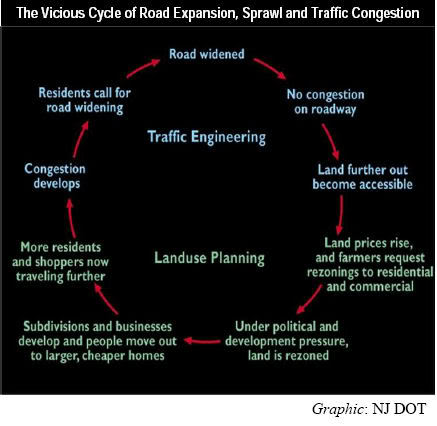
Pedestrian Safety
The study recommends both new road crossings to increase access to bus stops and new sidewalks along areas of the PCH where those on foot currently only have a shoulder to walk on. The improvements are in addition to a handful of new road crossings proposed by the City of Malibu.
The proposed new crosswalks are clustered at the south end of the project, where housing and attractions exist on the east side of the PCH and the beach is to the south.

However, there are still concerns that the proposal doesn’t go far enough, as at least one bus stop will be isolated even if the entire plan is approved and built.
“A point of concern for the repaving is at Rambla Vista, where there is a bus stop on each side of the road and no crosswalk or safe way to get to the other side,” Rose continues.
“A pedestrian is expected to walk about 1/4 mile in the road where there's no sidewalk and no shoulder — not even a foot (of shoulder). While there are additional pedestrian crossings being added as part of the repaving project, this crossing/bus stop area is ignored and it's NOT safe.”
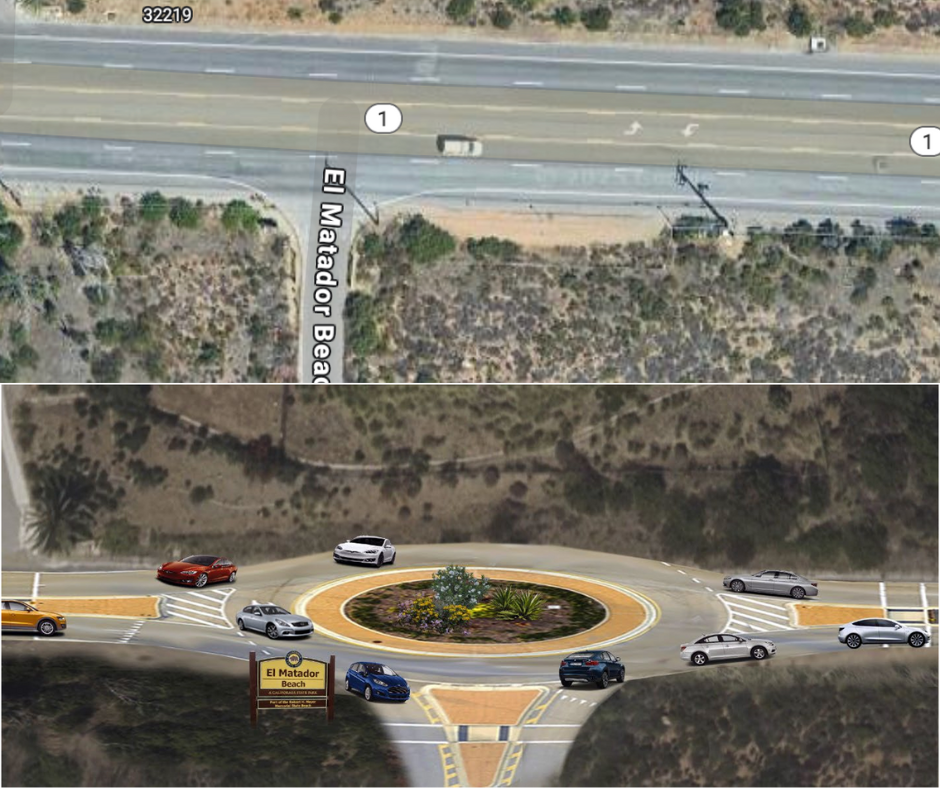
Traffic Calming
For the most part, the draft plan avoids specific locations for proposed traffic calming projects, but it does give a laundry list of things that should be studied along the corridor including: gateway signage, speed tables at high-traffic crossings, trees, and angled parking. The study does call for reducing the lane size to 10'-6” wide, the Caltrans minimum standard for Complete Streets.
The study does call out specific locations where traffic circles and roundabouts should be studied including the entrance to El Matador State Beach (image above). Currently, there is a T-intersection and cars traveling north have to turn west across two lanes of traffic to enter the beach parking lot. The proposal looks at two options and recommends narrowing the road to one lane and adding a traffic circle.
Next Steps
Following approval of the final plan, Caltrans can get right to work making improvements to the corridor. Some improvements will be coming more quickly than others, as the aforementioned PCH repaving project will begin construction in 2026 and be completed by 2029.

Following that, there will be a series of short improvements (above) done over the next decade but the major improvements won’t be in place until over a decade from now (excluding the proposed roundabout at El Matador Beach which will happen in the first decade).
Separated bike lanes, new sidewalks, and other improvements that require construction will be tackled in the plan's second decade. These improvements include any new trees, crosswalks, and enhancements for people with disabilities.
